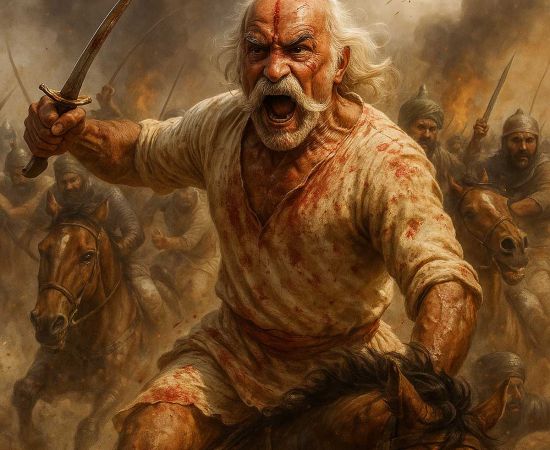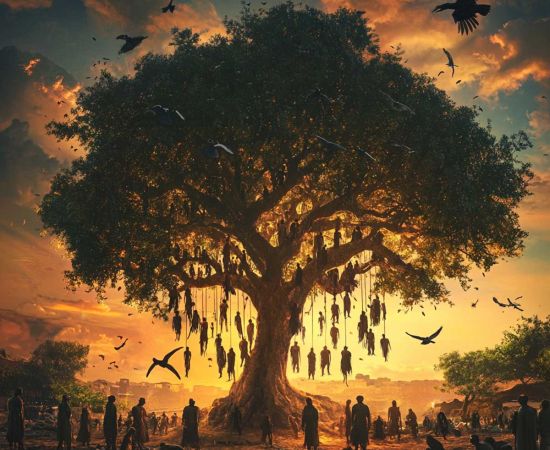MORE COVERAGE
Twitter Coverage
Satyaagrah
Written on
Satyaagrah
Written on
Satyaagrah
Written on
Satyaagrah
Written on
Satyaagrah
Written on
JOIN SATYAAGRAH SOCIAL MEDIA
"हुब्ब-ए-वतन": In a 'pre-planned attack' fueled by rumors of grave removals, an Islamist mob forcefully entered and vandalized several idols at Prerna Peeth Nishkalki Temple in Ahmedabad, causing significant unrest and outrage, according to VHP reports

On Wednesday evening, the 8th of May, a disturbing event unfolded at the Prerna Peeth Nishkalki Temple located in Pirana, Ahmedabad. A group, identified as an Islamist mob, targeted the temple, leading to significant damage. This incident has caught the attention of many as videos began circulating on social media, showing the attackers wearing skull caps and armed with sticks and iron rods.
|
The Vishwa Hindu Parishad (VHP) has described the attack as "pre-planned". During this assault, several Murtis (idols) of Hindu deities were reportedly vandalized, sparking outrage among the local Hindu community and religious leaders. The destruction of these idols is seen not just as a physical act of violence but as an affront to the religious sentiments of the community.
This temple has been at the center of a long-standing dispute that adds layers to the current incident. There has been an ongoing controversy concerning the identity of the site. The Muslim community has claimed that the location is a shrine, while the Hindu community is firm in its stance that it is indeed a temple. This disagreement has fueled tensions between the two groups for years, contributing to the charged atmosphere surrounding the recent attack.
Reason for the Attack
Similar to the well-known Bhojshala complex, the Prerna Peeth Nishkalki Temple has long been a flashpoint of religious tensions. This historic site has seen conflicting claims, with Muslim groups calling it a shrine, while Hindu groups insist it is a place of Hindu worship. This ongoing dispute has deeply affected the local community.
The recent violent incident at the temple was reportedly sparked by rumors that graves at the temple site had been disturbed. These rumors led to a gathering of local Muslims. According to reports, acting on these rumors, the mob forcibly entered the temple. Once inside, they caused significant damage, not only to the structure's walls but also to the religious icons housed within.
Videos capturing the attack have circulated widely, drawing widespread condemnation from various groups. Among the vocal critics were the Vishwa Hindu Parishad (VHP) and the Gujarat unit of the Bajrang Dal, both of which expressed strong disapproval of the violence.
|
Further amplifying concerns about the attack's nature, a video posted on the official Instagram account of the Vishwa Hindu Parishad, Gujarat, included a statement by the VHP claiming that the attack was "pre-planned." The organization also reported that several idols of Hindu Gods and Goddesses installed inside the temple were deliberately broken during the assault. Attempts by the news outlet OpIndia to contact the VHP for further comments were unsuccessful.
This incident has heightened tensions in the area, bringing to the forefront issues of religious respect and coexistence. The attack not only caused physical damage to the temple but also struck at the heart of the community, challenging the delicate balance of interfaith relations.
Bajrang Dal’s Gujarat unit also took to social media to post videos of the mob attack at the temple. Their post in Hindi clearly showed the gravity of the incident: “In this video, it is clearly visible that a large number of atheists broke the wall of the temple premises and entered inside and created a ruckus.”
Following the outbreak of violence, several law enforcement agencies were quick to respond. The Ahmedabad rural district police station, Special Operations Group (SOG), and Local Crime Branch (LCB) all intervened swiftly to restore peace. An investigation has been launched to identify and apprehend those responsible for the violence, with the aim of ensuring justice for the desecration of the temple.
|
The social media discussions following the incident also included thought-provoking statements reflecting the tension and potential implications of the attack. One such statement was: "Imagine this: If Muslims can consistently commit serious crimes under BJP rule and largely escape punishment, imagine the possibility as their political party gains more and more power."
Further comments highlighted a perceived bias in media coverage: "Such attacks on Hindu temples by Islamic mobs rarely make headlines in the leftist media..." Additionally, there was speculation about the possible global reaction to reversed roles: "Can you imagine the international outrage if Hindus had attacked mosques in India and torn copies of the Quran!? Muslims across the Islamic world march in the streets calling for death..."
Pirana Shrine a Hindu Place of Worship, Trust Submits Before Gujarat High Court
The controversy over the religious identity of the Pirana site continues to unfold. Recently, a Muslim trustee of the Imamshah Bawa Roza Sansthan, which claims to be the custodian of the Imam Shah Bawa dargah in Pirana, raised concerns about the site's current religious representation. In August 2023, this trustee wrote to the district collector, expressing dissatisfaction with the actions of Hindu trustees at the site.
The letter highlighted concerns over images and posters of Hindu deities being placed around the mausoleum. The trustee called for the collector’s intervention to help preserve the dargah's character, emphasizing its historical role as a symbol of Hindu-Muslim unity that has stood for centuries.
Further adding to the tensions, Sirajuddin Saiyed, who is an elected trustee of the same Sansthan, voiced specific grievances. He pointed out the increasing presence of Hindu religious symbols, describing it as the "saffronisation of the Imamshah Bawa dargah precincts" located on the outskirts of Ahmedabad. His objections were particularly strong regarding the posters and images of deities enveloping the mausoleum and a painting that depicted the 15th-century saint Imamshah Bawa with a tilak on his forehead, portraying him as a Hindu saint.
In his formal complaint, the trustee mentioned that he had approached the local police for intervention on Sunday. However, the police declined to get involved due to the ongoing litigation in the Gujarat High Court regarding this dispute. He disclosed that he had initially filed a petition in the high court when the Hindu faction of the trust began to assert its religious practices prominently within the shrine's precincts. Nevertheless, he withdrew this petition back in 2021.
Amidst these ongoing disputes, the Sunni Awami Forum, a Muslim organization, took legal action last year. They filed a Public Interest Litigation (PIL) challenging the construction of a new temple within the shrine precincts. This action was aimed at restricting such developments by invoking the Places of Worship Act, 1991, which aims to maintain the religious character of places of worship as they were in 1947.
In a significant turn of events on Monday, the trust managing the large religious site on the outskirts of Ahmedabad—the Imamshah Bawa Roza Trust—responded to the allegations made in the PIL. They asserted in the Gujarat High Court that the Pirana shrine is fundamentally a Hindu place of worship, countering the claims that it is predominantly a Muslim site.
Recently, in response to a Public Interest Litigation (PIL) initiated by the Sunni Awami Forum, the trust responsible for managing the site presented a detailed defense. The trust's advocate, S K Patel, asserted, "The Pirana shrine, which houses a 600-year-old mosque, dargah, and various temples, is essentially a Hindu place of worship. To say it is fundamentally a Muslim institution is wrong." This statement was part of a formal reply filed by the trust.
The trust's claim is grounded in historical and legal precedents. They referenced a scheme approved by the authorities in 1939, which laid the foundation for the formation of the trust. According to this scheme, the Pirana shrine was designated as an institution for Hindu Satpanthi or Satsangis, indicating a primarily Hindu orientation despite the presence of Islamic architectural elements and spaces.
The litigation by the Sunni Awami Forum was initiated in June when they approached the High Court with concerns that the current trust was altering the Islamic character of the place to reflect Hindu religious beliefs. This action invoked the Places of Worship Act, which seeks to preserve the religious character of places of worship as they existed in 1947.
In a counter-argument, the trust highlighted a previous legal attempt by the Saiyed trustees, who had sought to have the religious site declared a waqf property. However, this request was declined by the charity commissioner. The decision of the charity commissioner was subsequently upheld by a district court, the high court, and the Supreme Court, reinforcing the trust’s stance and the site’s status as defined by the 1939 scheme.
In a pivotal legal filing, the Public Interest Litigation (PIL) brought forth by the Sunni Awami Forum made serious allegations regarding the Pirana shrine. The PIL claimed that there had been a series of "unconstitutional and illegal conversion of Pir Imamshah Bawa Dargah and its surrounding Muslim religious places to Hindu structures" in recent years. It was specifically noted that the existing dargah is being converted to Shree Nishkalanki Maharaj, and Imamshah Bawa Roza is being transformed into the Shree Nishkalanki Narayan Tirthdham Pranpith.
The PIL expressed concerns over these transformations, suggesting a deliberate alteration of the religious identity of these sites from Islamic to Hindu. This issue has been a significant point of contention, reflecting deeper historical and communal dynamics over religious spaces in the region.
However, the court's decision did not favor the claims made by the Sunni Awami Forum. The PIL was not only dismissed but the site was declared a Hindu place of worship based on its historical and legal merits. This decision was influenced by evidence and legal arguments that highlighted the site's long-standing association with Hindu practices, despite the presence of Islamic religious structures.
Well, Muslims have long tendency of converting Hindu places of worships and playing victimhood if Hindus take ownership of their rightful property. This PIL was declined. Need we say any more. This encapsulates the sentiments of those who feel vindicated by the court’s decision, seeing it as a rightful restoration of the religious site to its original status.
This case at the Pirana shrine is emblematic of the complex interplay between law, history, and religion in India, where legal battles over religious sites often reflect broader societal issues regarding heritage, identity, and communal harmony.
 |
 Support Us
Support Us
Satyagraha was born from the heart of our land, with an undying aim to unveil the true essence of Bharat. It seeks to illuminate the hidden tales of our valiant freedom fighters and the rich chronicles that haven't yet sung their complete melody in the mainstream.
While platforms like NDTV and 'The Wire' effortlessly garner funds under the banner of safeguarding democracy, we at Satyagraha walk a different path. Our strength and resonance come from you. In this journey to weave a stronger Bharat, every little contribution amplifies our voice. Let's come together, contribute as you can, and champion the true spirit of our nation.
 |  |  |
| ICICI Bank of Satyaagrah | Razorpay Bank of Satyaagrah | PayPal Bank of Satyaagrah - For International Payments |
If all above doesn't work, then try the LINK below:
Please share the article on other platforms
DISCLAIMER: The author is solely responsible for the views expressed in this article. The author carries the responsibility for citing and/or licensing of images utilized within the text. The website also frequently uses non-commercial images for representational purposes only in line with the article. We are not responsible for the authenticity of such images. If some images have a copyright issue, we request the person/entity to contact us at This email address is being protected from spambots. You need JavaScript enabled to view it. and we will take the necessary actions to resolve the issue.
Related Articles
- Bulldozer out to teach a lesson to criminals, rioters who create unrest in the society: Razed off all the shops near the dargah in Khambhat where stone-pelting took place on the chariots in Rath Yatra procession, Gujarat
- Innocent Young Muslim children are being taught ‘how to kill Hindus’: Radicalisation, hate, and bigotry are ruining another generation, hundreds of videos on social media where children are seen declaring their desire to kill 'kaafirs'
- In a harrowing incident, Geeta, a resident of Nibiya village, was in a mustard field with her one-year-old daughter when Mohammad Bhondu Rehman, a 50-year-old man from the neighborhood, horrifically abducted her, and brutally raped her
- "Case regarding same status to national song as that of national anthem is underway in court": Insult to National Song in Municipal Council meeting in Muzaffarnagar, 4 burqa-clad women remain seated as the house stands in honour of Vande Mataram
- Islamic revivalist movements in Bharat and Deoband’s link to Taliban
- Jodhpur witnesses rampant violence on Eid as mob goes on a rampage after Namaz: Muslim mob replaced Bhagwa flag with an Islamic flag at Jalori intersection
- ‘Liberal’ elites has issue with Hindu identity of PM Modi and emphasize "Aakhir Albert Pinto Ko Darr Kyun Lagta Hai" – Deciphering the latest rants of Naseeruddin Shah
- Massive endorsement of anti-Grooming Jihad laws: Here are the takeaways from the Kashmir controversy and how Khalistanis swallowed a bitter pill
- Ramzan Ali led Muslim mob brutally attacked two Hindu youths, Jatin and Pankaj, and dumped them in the gutter - Jatin dead – Delhi
- "अम्न-ए-आलम": Devotees returning from a Hanuman Chalisa recital in Bihar’s Jamui brutally attacked by Islamists with stone pelting in police presence, injuring many, including Nitish Sahu and Khushbu Pandey; eight arrested, internet suspended
- As Hindus across the world celebrate Ram Navami, in India Islamists unleash mayhem in 5 Indian states to stop Hindu processions, engaged in stone-pelting, targeted attacks, arson, violence, and vandalism: Not a new phenomenon in India
- Flower seller Madhu, another Hindu youth after #HarshaMurder assaulted and stabbed by a mob led by Tauseef with a long sword kind of weapons in broad daylight on the streets of Shivamogga at New Mandli locality in Karnataka
- Waqf board gets stay on demolition of illegal madarsa after Surat Municipal Corporation fails to update records on time, may hijack second property in just 3 months: Land Jihad surges in Gujarat
- If not for Muslim appeasement, Vande Mataram would have been India's National Anthem: the history of Muslim opposition and support
- Muslims pretended to offer Friday Namaz, gathered mob at Gyanvapi Mosque in Varanasi and raised religious slogans as the survey and videography of disputed structure started



























